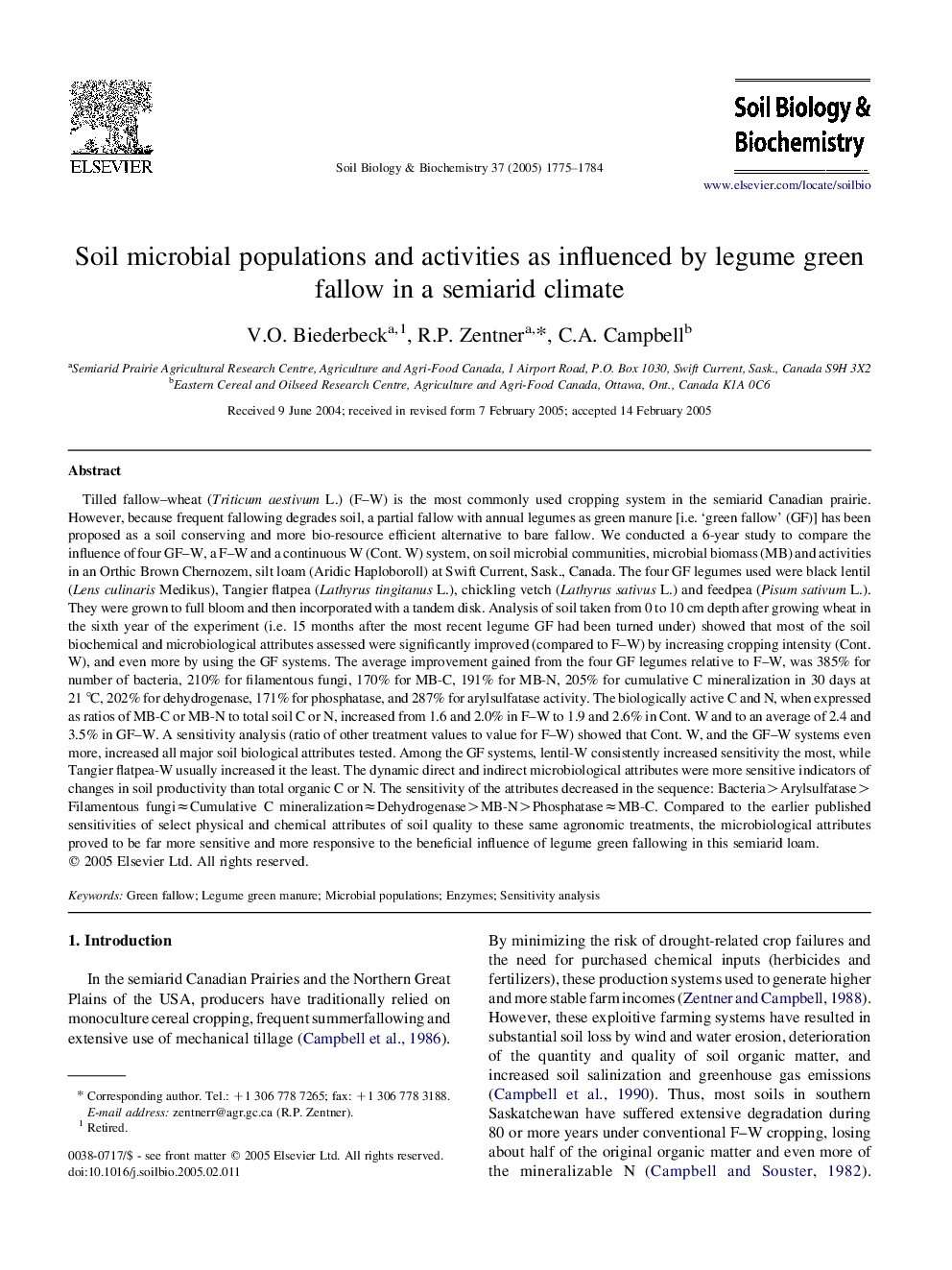| کد مقاله | کد نشریه | سال انتشار | مقاله انگلیسی | نسخه تمام متن |
|---|---|---|---|---|
| 10846253 | 1070046 | 2005 | 10 صفحه PDF | دانلود رایگان |
عنوان انگلیسی مقاله ISI
Soil microbial populations and activities as influenced by legume green fallow in a semiarid climate
دانلود مقاله + سفارش ترجمه
دانلود مقاله ISI انگلیسی
رایگان برای ایرانیان
کلمات کلیدی
موضوعات مرتبط
علوم زیستی و بیوفناوری
علوم کشاورزی و بیولوژیک
دانش خاک شناسی
پیش نمایش صفحه اول مقاله

چکیده انگلیسی
Tilled fallow-wheat (Triticum aestivum L.) (F-W) is the most commonly used cropping system in the semiarid Canadian prairie. However, because frequent fallowing degrades soil, a partial fallow with annual legumes as green manure [i.e. 'green fallow' (GF)] has been proposed as a soil conserving and more bio-resource efficient alternative to bare fallow. We conducted a 6-year study to compare the influence of four GF-W, a F-W and a continuous W (Cont. W) system, on soil microbial communities, microbial biomass (MB) and activities in an Orthic Brown Chernozem, silt loam (Aridic Haploboroll) at Swift Current, Sask., Canada. The four GF legumes used were black lentil (Lens culinaris Medikus), Tangier flatpea (Lathyrus tingitanus L.), chickling vetch (Lathyrus sativus L.) and feedpea (Pisum sativum L.). They were grown to full bloom and then incorporated with a tandem disk. Analysis of soil taken from 0 to 10 cm depth after growing wheat in the sixth year of the experiment (i.e. 15 months after the most recent legume GF had been turned under) showed that most of the soil biochemical and microbiological attributes assessed were significantly improved (compared to F-W) by increasing cropping intensity (Cont. W), and even more by using the GF systems. The average improvement gained from the four GF legumes relative to F-W, was 385% for number of bacteria, 210% for filamentous fungi, 170% for MB-C, 191% for MB-N, 205% for cumulative C mineralization in 30 days at 21 °C, 202% for dehydrogenase, 171% for phosphatase, and 287% for arylsulfatase activity. The biologically active C and N, when expressed as ratios of MB-C or MB-N to total soil C or N, increased from 1.6 and 2.0% in F-W to 1.9 and 2.6% in Cont. W and to an average of 2.4 and 3.5% in GF-W. A sensitivity analysis (ratio of other treatment values to value for F-W) showed that Cont. W, and the GF-W systems even more, increased all major soil biological attributes tested. Among the GF systems, lentil-W consistently increased sensitivity the most, while Tangier flatpea-W usually increased it the least. The dynamic direct and indirect microbiological attributes were more sensitive indicators of changes in soil productivity than total organic C or N. The sensitivity of the attributes decreased in the sequence: Bacteria>Arylsulfatase>Filamentous fungiâCumulative C mineralizationâDehydrogenase>MB-N>PhosphataseâMB-C. Compared to the earlier published sensitivities of select physical and chemical attributes of soil quality to these same agronomic treatments, the microbiological attributes proved to be far more sensitive and more responsive to the beneficial influence of legume green fallowing in this semiarid loam.
ناشر
Database: Elsevier - ScienceDirect (ساینس دایرکت)
Journal: Soil Biology and Biochemistry - Volume 37, Issue 10, October 2005, Pages 1775-1784
Journal: Soil Biology and Biochemistry - Volume 37, Issue 10, October 2005, Pages 1775-1784
نویسندگان
V.O. Biederbeck, R.P. Zentner, C.A. Campbell,